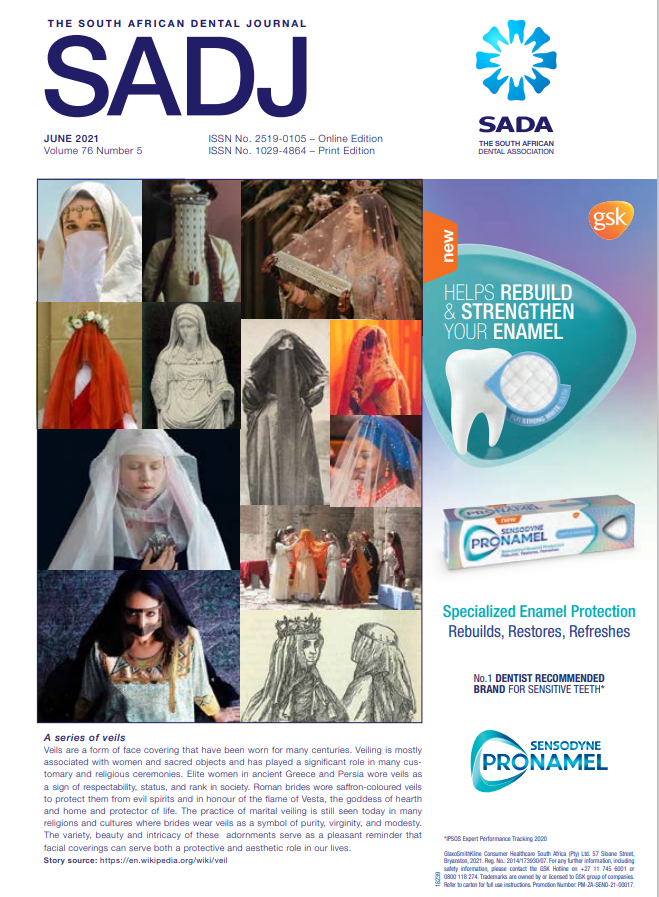The relationship between the mechanism of injury and mandibular fractures
DOI:
https://doi.org/10.17159/10.17159/2519-0105/2021/v76no5a1Keywords:
Mandible, fracture, trauma, maxillofacial, injury, jaw.Abstract
This prospective study describes the mechanism of injury, patient demographics and clinical presentation of 100 consecutive patients encountered in the patient population served by the Department of Maxillofacial and Oral Surgery at the Sefako Makgatho Health Sciences University. To determine the demographics, presentation and mechanism of injury of patients presenting with mandibular fractures in the patient population served by Sefako Makgatho Health Sciences University. Seventy percent of mandibular fractures were secondary to assault. Although this was high in comparison to other studies, it was similar to studies performed in London and other regions of South Africa. Mandibular fractures resulting from MVA (motor vehicle accidents), falls and sports were found to be less than the norm. The high percentage of mandibular fractures due to assault concurs with similar studies previously conducted in South Africa. With some variables similar to international trends, while others are not; certain salient results highlight the need for interventional campaigns.
Downloads
References
Breasted J. Edwin Smith surgical papyrus. Facsimile and hieroglyphic transliteration with translation and commentary. American Journal of Oral Surgery. 1944; 30: 399-504.
Mukerji R, Mukerji G, McGurk M. Mandibular fractures: Historical perspective. Br J Oral Maxillofacial Surg. 2006 Jun; 44(3): 222-8.
Gartshore L. A brief account of the life of René Le Fort. Br J Oral Maxillofacial Surg. 2010 April; 48(3): 173-5.
Miloro M. Peterson’s principals of oral and maxillofacial surgery. 2nd ed. London: BC Decker; 2004.
Petzel J-R, Bülles G. Experimental studies of the fracture behaviour of the mandibular condylar process. J Maxillofac Surg. 1981; 9: 211–5.
Santos LS, Rossi AC, Freire AR, Matoso RI, Caria PH, Prado FB. Finite-element analysis of 3 situations of trauma in the human edentulous mandible. J Oral Maxillofac Surg. Apr 2015;
(4): 683-91.
Duan DH, Zhang Y. Does the presence of mandibular third molars increase the risk of angle fracture and simultaneously decrease the risk of condylar fracture? Int J Oral Maxillofac
Surg. Jan 2008; 37(1): 25-8.
Pappachan B, Alexander M. Biomechanics of cranio-maxillofacial trauma. J Maxillofac Oral Surg. Jun 2012; 11(2): 224-30.
Streian F, Argesanu V, Kulcsar RM, Borozan IS, Jula M, Talpos-Niculescu C. Human Body Posture before and after Maxillofacial Surgery. Procedia Engineering. 2014; 69: 508-11.
Bryant J, Thompson S, Finklea BW. Fundamentals of Media Effects. 2nd ed. Illinois: Waveland Press. 2013.
Bianchi G. Alcohol Use and Sexual Risk Behaviour: A CrossCultural Study in Eight Countries. Geneva: WHO press; 2005.
Desai J, Lownie JF, Cleaton-Jones P. Prospective audit of mandibular fractures at the Charlotte Maxeke Johannesburg Academic Hospital. S Afr J Surg. Nov 2010; 48(4): 122-6.
Porter M, Lownie M, Cleaton-Jones P. Maxillofacial injury: a retrospective analysis of time lapse between injury and treatment in a South African academic maxillofacial and oral
surgery unit. S Afr J Surg. 2013 Oct 22; 51(4): 138-42.
Cabalag MS, Wasiak J, Andrew NE, Tang J, Kirby JC, Morgan DJ. Epidemiology and management of maxillofacial fractures in an Australian trauma centre. J Plast Reconstr Aesthet Surg.
Feb 2014; 67(2):183-9.
Gassner R, Tuli T, Hächl O, Rudisch A, Ulmer H. Craniomaxillofacial trauma: a 10 year review of 9543 cases with 21 067 injuries. J Craniomaxillofac Surg. Feb 2003; 31(1): 51-61.
Dhaif G, Ramaraj R, Magra A, Yasser A, Al-Sammak N. Mandibular fractures in Bahrain- A 10 year study. Bahrain Med Bull. Sep 1996; 18(3).
Chrcanovic BR, Abreu MH, Freire-Maia B, Souza LN. 1,454 mandibular fractures: a 3-year study in a hospital in Belo Horizonte, Brazil. J Craniomaxillofac Surg. 2012 Feb; 40(2):
-23.
Ongodia D, Zhi Li Z, Hai-Hua Zhou HH, Zu-Bing Li ZB. Comparative analysis of trends in the treatment of mandibular fractures. J Oral Maxfac Surg. July 2014; 26(3): 276-9.
Rashid A, Eyeson J, Haider D, van Gijn D, Fan K. Incidence and patterns of mandibular fractures during a 5-year period ina London teaching hospital. Br J Oral Maxillofac Surg. Dec
; 51 (8): 794-8.
Boffano P, Roccia F, Zavattero E, Dediol E, Uglesic V, Kovacic Z, et al. European Maxillofacial Trauma (EURMAT) project: A multicentre and prospective study. J Craniomaxillofac Surg. Jan 2015; 43(1): 62-70. doi: 10.1016/j.jcms.2014.10.011. Epub 2014 Oct 22.
Anyanechi CE & Saheeb BD. Mandibular sites prone to fracture: analysis of 174 cases in a Nigerian tertiary hospital. Ghana Med J. 2011 Sep; 45(3): 111-4.
Adeyemo WL, Iwegbu IO, Bello SA, Okoturo E, Olaitan AA, Ladeinde AL, et al. Management of mandibular fractures in a developing country: a review of 314 cases from two urban
centers in Nigeria. World J Surg. Dec 2008; 32(12): 2631-5.
Singh AS. An audit of maxillofacial fractures in patients attending the Medunsa Oral Health Centre, University of Limpopo, Medunsa Campus. [Updated 2009 June; cited 22 October
. Available from: http://hdl.handle.net/10539/7315.
Suleman YF. Aetiology and mechanism of injury of midfacial fractures: a prospective study of the Johannesburg region. [Updated 2008; cited 22 October 2014]. Available from: http://
hdl.handle.net/10539/7350. Roode GJ, van Wyk PJ, Botha SJ. Mandibular Fractures: anEpidemiological Survey at the Oral and Dental Hospital, Pretoria. SADJ. Jul 2007; 62(6): 270, 272-4.
Goodman J. The wages of sinistrality: handedness, brain structure and human capital accumulation. Journal of Economic Perspectives. 2014; 28(4): 1
Downloads
Published
Issue
Section
License
Copyright (c) 2021 Irshaad Abdoola, Michael MR Bouckaert, Irene Munzhelele, Muniera Ibrahim, James M Mchenga

This work is licensed under a Creative Commons Attribution-NonCommercial 4.0 International License.






.png)